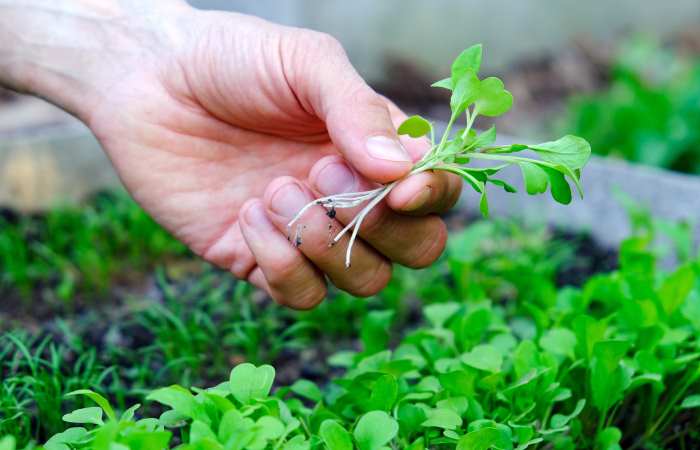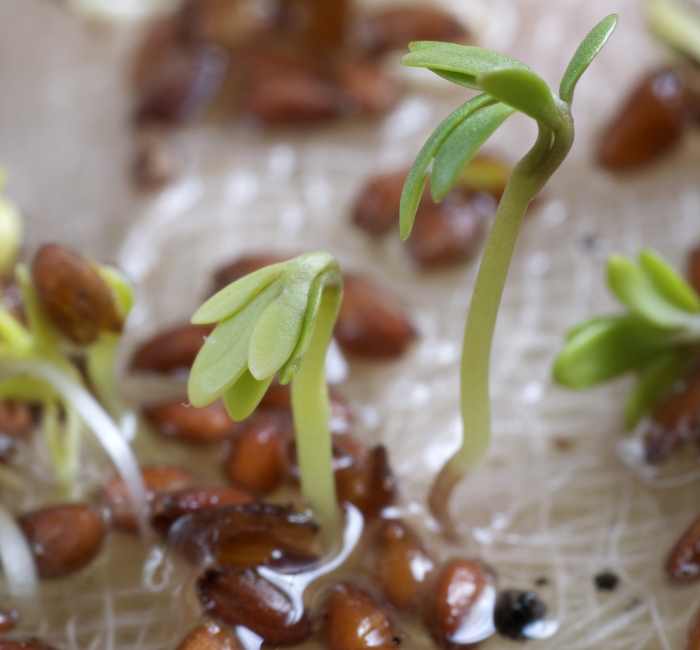Many people assume that sprouts and microgreens are the same things, but is this true?
While both are small, green, and make a healthy and delicious addition to all types of dishes, microgreens and sprouts are not the same things.

So what is the difference between sprouts and microgreens, and is one a better than the other?
In this article, I explain precisely what sprouts and microgreens are. I discuss how they grow, the difference in the taste and nutrition value, and safety concerns so you’ll never confuse the two again.
What Is A Sprout?
When a seed starts to germinate, a tiny live plant bursts from the seed shell in the form of a shoot. This shoot is called a sprout.

Sprouts use the nutrients within the seed to start growing this short stem. They don’t require soil to develop, only an optimal temperature and water.
Sprouts grow in only a few days, which make them a quick source of food and nutrients for people and animals.
When speaking about sprouts sold in stores or used in restaurants, they are most often from the seeds of alfalfa beans, but you can utilize many other seeds and beans like:
- Radish
- Broccoli
- Mustard
- Clover
- Sunflower
- Soy
- Pumpkin
- Garlic
As sprouts grow, minerals like calcium and magnesium will bind to the protein in the seed, which then transports into the plant, which adds to their nutritional value.
Once sprouts reach several inches long, they are ready for harvest.
What Is A Microgreen?
A microgreen is a vegetable or herb seedling grown in a soil medium. While the initial growth looks similar to sprouts, microgreens are left to mature through the plant’s cotyledon growth stage.
See our list of microgreens for various types and options to add to your garden or kitchen.

Mustard is one of the best microgreens to grow because of it’s spicy kick and available color options.
The cotyledon is a part of the embryo in the seed that grows into the plant’s first set of leaves.
Those first leaves transfer energy from sunlight and help in the absorption of the minerals from the planting soil. These leaves help the plant grow faster.
Farmers harvest microgreens after the first cotyledon leaves appear and frequently after the first set of real leaves begin to form. The stems are cut off at the soil line, and the upper portion is what farmers ship to stores and restaurants.
Microgreens come in a wide array of colors and ranges of flavors which make them a favorite of chefs, who use them to add taste and visual interest to dishes.
Planting And Growth Differences
Sprouts and microgreens begin life from the same seeds. The seeds will grow in different mediums, including soil-less hydroponic systems,and the way farmers harvest them is modified.
Sprouts do not require light, nutrients, or soil to grow. They grow in water. On average, sprouts grow to maturity in under seven days.
Sprouts are ready when they reach the stage near the formation of the first tender leaves. The sprouts get a rinse, and the whole plant (seed, root, stem, leaf) is ready to eat.
Microgreens grow in a soil medium until the first two to four leaves appear. This growth process takes between one and three weeks.
Microgreens grow best in bright light with low humidity levels. A soil rich in nutrients is beneficial to the health and “healthiness” of the microgreen.
Once microgreens reach maturity, the farmer trims to remove the root system and packages them for sale. The stem and leaves are edible.
Do Sprouts And Microgreens Taste Different?
Sprouts and microgreens are very different when it comes to taste.
Sprouts usually have a firm outer texture, but the inside of the shoot is very watery. Since sprouts are just days old, the flavor can be minimal.
Alfalfa sprouts have a very mild taste, while beet sprouts are dark red or pink with a sweet, earthy flavor. Broccoli sprouts tend to have a nutty flavor with a hint of spiciness.
Sprouts are most often put into sandwiches or on salads for some crunch and a nutritional boost.
Microgreens are more mature than sprouts and take on the flavor of it’s “adult” counterpart. This feature is what makes microgreens an excellent garnish for a wide array of dishes.
Radish microgreens have a pink stem and very spicy kick. For a lemony and nutty flavor combination try sunflower microgreens. My personal favorite is pea microgreens that are slightly sweet and mild.
Nutrition And Safety
Sprouts add beneficial protein, fiber, enzymes, antioxidants, and other trace nutrients to your diet.
Microgreens offer a tremendous nutritional advantage over sprouts since they are more mature and absorb nutrients from the growing medium.
Alfalfa sprouts provide many vitamins, while clover sprouts have iron, calcium, and potassium. Each sprout variety will offer distinct nutritional elements.
Microgreens offer up potassium, iron, magnesium, zinc, calcium, phosphorus, vitamins, chlorophyll, amino acids, and more.
Sprouts grow in a humid environment which bacteria love. Be cautious when preparing sprouts for consumption to lower risk of bacterial growth that can make you sick.
Cooking sprouts should kill bacteria. Keep raw sprouts in the fridge. Never eat sprouts that smell bad or have a “rusty” appearance. Sprouts are edible for about a week.
Due to the growing conditions, microgreens don’t have a high risk of bacteria being present. Brown spots or slimy leaves indicate it’s gone bad.
In Summary
To sum it up, the difference between sprouts and microgreens is apparent once you look deeper. The method I use to remember the difference is to picture sprouts as “shoots” and microgreens as having “micro leaves.”
While microgreens have a nutritional edge, both sprouts and microgreens are a beneficial addition to any dish for flavor, texture, vitamins, and minerals.
I hope this article was a helpful way to learn more about sprouts and microgreens and to end any confusion between the two.
I encourage you to taste-test different varieties or try your hand at growing microgreens and sprouts at home!










